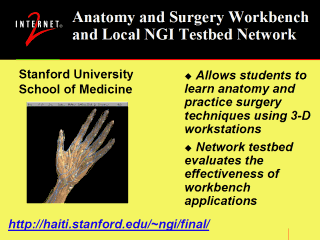 |
SUMMITís Next Generation
Internet (NGI) testbed network within the Stanford School of Medicine evaluates the
effectiveness of the Anatomy and Surgery Workbench applications. The testbed network links
selected classrooms, labs, clinical departments, and the medical library using a
high-speed gigabit Ethernet backbone. The new 3-D Learning Space and connected classrooms
allow students to learn anatomy and basic surgical skills through the use of 3-D
workstations, haptic (touch sensitive) devices, stereoscopic displays, distributed rich
media databases, and application program servers. Both applications support synchronous
collaboration through a shared virtual workspace and will use haptic feedback to augment
the visual sense. This technology permits the definition of new curricular elements
including the repeated dissection of anatomical structures, visual segmentation of raw
data sets, creation of 3-D organ models, and the practice of fundamental surgical
maneuvers. The capabilities of Internet2 high-performance networks and use of a
distributed client-server system allow teachers and users to share online, image-rich
data, and professional experiences. |
